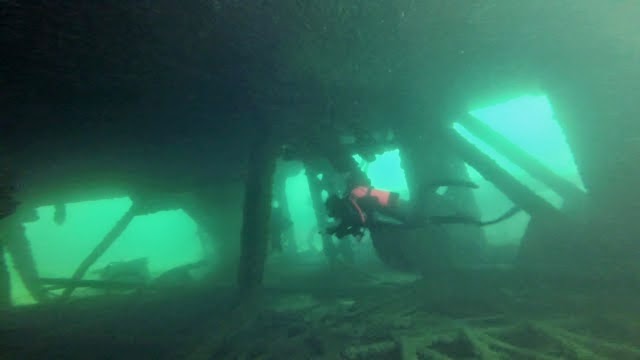One of the first things we learn as divers is to fill out
our log books. It's important to keep
track of the number and details of your dives especially as you progress with
more advanced training. I log each one
of my dives and include notes, sites dive buddies etc. The technical portions of the dives are
copied off of our dive computers. Items
such as depth, time, dive time, surface interval etc.
With modern dive computers comes the ability to communicate
from computer to computer. Now we can
download the information stored in the computer to a PC. What`s the point of that? Well actually there are several. I dislike
the process using my thumbs to navigate through the menu on the dive
computer. I would rather let the
computers do that. I also dislike
writing down all the technical details mentioned earlier. It isn't terrible but I prefer to do it all
at once when I feel like it rather than right after a dive. I also like the ability to tie pictures that
I've taken on a dive to the specific log off that dive. It makes them both more interesting
together. Finally the biggest reason to
do that is that I am a dive geek, in mathematical terms; Diver + Geek = Dive
Geek = Tater.
After spending some time on the Google machine to
investigate, I found one of the packages that sounded the best was called Dive
Log 5.0., the problem with it was the cost; roughly $50. As any tightfisted engineer would know, you
just don't plunk down some cash based on the marketing of a product. But a good manufacturer will understand that
and let you try it. I downloaded the
free demo and started to play with it. I
was not completely sold (Manta and/or my wife will enthusiastically confirm that
I don't buy anything quickly)
$50 is a lot more money than my log book refills!! On the
other hand since I don't have any quarry fees, motel stays or dive refreshments
to buy until summer, $50 for a onetime fee doesn't see too terrible. In a weak moment I pulled the trigger and
ordered it.
One of the features I like the best about the software is
the ability to connect my dive computer to the laptop and just download the
most recent dives. I simply connect the cable from my Suunto Vyper to the PC
using the provided USB interface cable, go to the download menu in Dive log 5.0
and press the button. Dives are
automatically added to the end of the existing dive log. You can then edit anything about the log
entry including the dive number. This is
a real must for several reasons. First
if you are like me you may want to enter a bunch of dives from before you got
the dive computer. Second, I don't
consider every dive that my computer logs to be a separate dive. Sometimes we just surface to adjust gear, get
our bearings, help a student etc.. I
often combine dives after they are downloaded.
I can take what the computer calls 3 separate dives of 3 minutes, 10
minutes and 15 minutes respectively and just modify the log into 1 dive of 28
minutes. If I take my dive computer into
a Manta Pool Session it gets logged as a dive and I can just delete that
one.

The details that are downloaded to a log will vary according
you your dive computer. A dive computer
such as the Atomic Cobalt provides a lot more information that does my Suunto
Vyper, but I have the ability to add to or overwrite any information that is
downloaded.
Once you have the dive information logged in correctly you
can really start to use the software as you like. I always like to add a few notes to each log
just as you would in a logbook version such as what fish you saw, who your dive
buddy was, visibility etc. There are a
lot of built in information in the software that you can use such as dive
buddies (which it keeps track of so you can just pick names or groups on
subsequent dives), Tank Pressure,
etc. You would sort of expect that in an
electronic log and it is all there. In
addition, there are categories of dives that you can use such as Night Dive,
Deep Dive, Teaching, Leading, etc.
These items are also tracked for other uses. But wait, there's more!!
One fun little tool is that you can use maps to track the
location of your dives. Not just say
'Pearl Lake' but you can attach an actual map location to it as you might with Google
maps. This information is also stored and can be selected on future dives.
Another fun and/or useful things that the package does is
give you the ability to get statistics from the stored dive logs such as how
many of a particular type of dive, location of a dive, how many dives with a
particular dive buddy, how much total
time under water, number of dives in a location etc. Nothing like a nice graph to get a geek's
heart racing :)

Probably one of my favorite features is the ability to add
pictures to the dive log. I take a fair
number of GoPro pictures and while I sometimes make YouTube type videos out of
them, I almost as often grab snapshots out of the video. There is a drawback here that the software
does not support video. I spoke with the
developer and he is hoping to add that to future versions but for now it only
supports pictures. You can attach
pictures to each dive so that 2 years from now flipping through your log, you
can tie the photo to the specific dive and dive log information. I really enjoy this because I can now take
the pictures from say Cayman Brac and directly tie them not only to Cayman
Brac, but the specific dive, dive Buddy depth, dive site name etc. I find that connecting the picture with the
dive specifics makes the picture more interesting and also the dive log entry
more interesting by tying the memory all together. (This is especially helpful as I get old,
senile and get in more dives)

But wait! There's more!! Aside from the advantages of the software,
they have a working relationship with other software vendors for both Android
and Mac. Who cares? Well there is a big advantage there in my
book.
Many of us have done dive trips to remote tropical
locations. One of the big problems with
flying with dive gear is packing. Weight and space for a dive trip are at a
premium and can be very expensive if you go over the restriction. Well one of the things I carry with me on
trips is my laptop. I have an older
15" Dell that I take mostly to use with my GoPro so I can download the
video. Mine weighs a few pounds and is
about 2 inches thick. What if I didn't
have to take it? What if I could use a
7" tablet and download save all of my video files to the tablet or a
memory stick? Well I can. And now I also have the ability to download
my dive computer to my tablet. Dive Log
5.0 works with an Android application called Divemate USB. I can load all of my electronic dive logs
(minus pictures) onto a cloud application called Dropbox and use it to transfer
all of my log information onto my Android tablet
as well as my phone using Divemate.
It is a separate application but holds all the same
information except the pictures (pictures can be added to but are not automatic
and I wouldn't waste the memory space).
It is two way sharing in that I can also use Divemate to download new
dives from my Vyper directly to my tablet and Divemate will allow me to
transfer the information back to my PC and the Dive Log software through the
Dropbox. Oh man Jimmy Ray you gotta be
lovin' this!!!
I love the fact that I can use both packages for the same
information and each has some advantages.
For example Divemate has a built in feature of combining dives, which I
previously mentioned I do manually in Dive Log.
But I much prefer the Dive Log software because of the statistics and
generally more comfortable viewing on the larger screen.
I don't claim this is for everyone and there are a couple of
drawbacks. If you want to log previous
dives to catch up to your current dive (which you do not HAVE to do) you either
need really good information or it can distort some of the statistics that it
produces. For example if you don't have
a detailed record of your tank pressure delta on a given dive or dives, it will
be included in your SAC calculations and can throw that off.
If I lived somewhere I could dive 150-200 dives a year, I
might skip all the features and just use it because it was easier but since I
generally have several months of the year where all I can do is dream about
diving and re-live past dives, I really do like the product and messing around
to find all kinds of things such as number of dives at a given depth,
temperature, number of dives by month, number of dives with particular dive
buddies, training dives, night dives etc. as well as being able to put the
right pictures with the right dives. And oh boy, who doesn't like a good
graph?? But wait, there's more!!
Call Manta Divers now and get a free air fill with any gear
purchase over $200 with one easy payment.
Yes you heard right, that's a $10 savings if you call now. Operators are standing by.
Photo Credit: All Photos in this blog post are the work of Scott Durban































